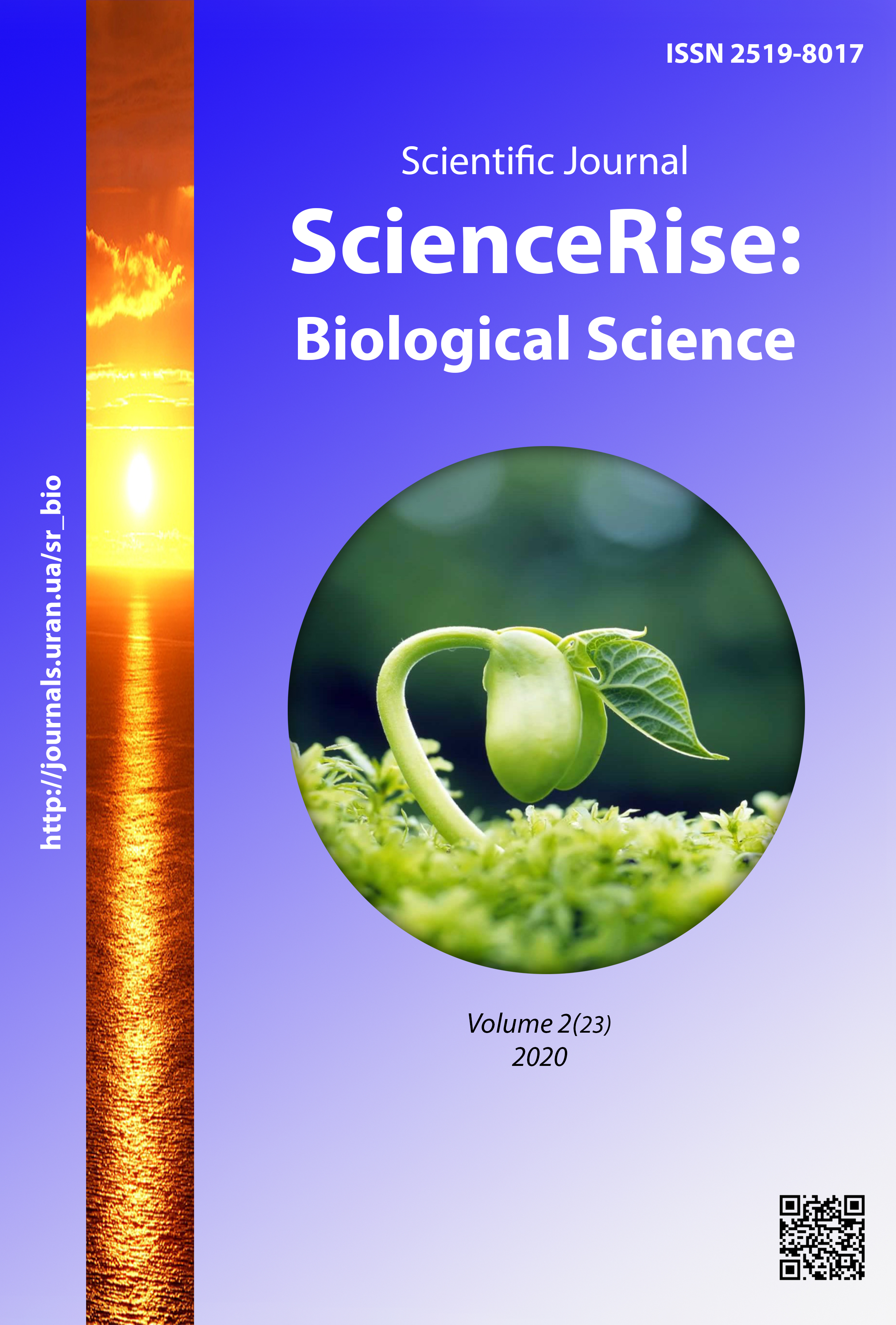Resistance of lines of winter bread wheat created with the participation of spring-winter hybrids to leaf stead diseases
DOI:
https://doi.org/10.15587/2519-8025.2020.206095Keywords:
wheat lines, pathogens, resistance, elements of productivity, yieldAbstract
When studying the collection of spring soft wheat of different genetic origin, individual samples that are resistant to pathogens and can be used as sources of resistance to pathogens in their hybridization with winter varieties were selected.
The aim of our research was to study the level of resistance to pathogens of leaf-stem diseases of spring-winter hybrids of different generations depending on the winter and spring components of crossbreeding and their genetic origin, as well as the effectiveness of selection on artificial infectious and natural backgrounds to obtain disease-resistant, with a set of economically valuable features and properties.
Materials and methods. The main method of creating a new hybrid material is intraspecific hybridization of spring and winter soft wheat, followed by selection of stable genotypes of different generations on natural (against powdery mildew) and artificial infectious (against brown and stem rust) backgrounds.
The source of material for the research was a collection of samples of spring soft wheat of different genetic and ecological-geographical origin in the amount of 101 pcs, Lines F3 (18 pcs.), F4 (141 pcs.) and F5 (66 pcs.), Created from combinations crossing of spring samples with varieties of the Breeding and Genetic Institute - National Center for Seed Science and Variety Research, different in biological properties. Evaluation of collection varieties and lines was performed according to the generally accepted methods of variety testing.
Result. The results of studying the resistance of F3-5 wheat lines created on the basis of spring-winter hybrids to the main pathogens on a natural and artificially created infectious background are presented. The links between resistance to pathogens and the main economic and valuable traits in wheat lines have been identified. Wheat lines with complex resistance to leaf-stem pathogens were obtained.
Conclusions. Dedicated winter bread wheat lines which combine in their genotype relative disease resistance with high productivity. These lines are mainly created from crossing spring specimens of Mexican, Western European, Canadian and Russian origin with local winter varieties
References
- Alfimov, V. A., Bespalova, L. A., Puzyrnaia, O. IU. (2001). Ustoichivost sortov ozimoi pshenicy v sviazi s izmeneniiami rasovogo sostava v populiacii buroi rzhavchiny Krasnodarskogo kraia. Pshenica i tritikale. Krasnodar, 306–317.
- Krivchenko, V. I. (1979). Ispolzovanie genofonda v selekcii selskokhoziaistvennykh kultur na ustoichivost k vrednym organizmam. Problemy zaschity rastenii ot vreditelei, boleznei i sorniakov. Moscow: «Kolos», 114–118.
- Dmitriev, A. P. (2003). Osobennosti biologii vzaimootnoshenii v sisteme parazit-khoziain kak osnova vybora tipa ustoichivosti zernovykh kultur k rzhavchine. Tipy ustoichivosti rastenii k bolezniam. Saint Petersburg, 33–34.
- Grigoreva, O. G. (1987). Donory effektivnykh genov ustoichivosti k steblevoi rzhavchine pshenicy. Problemy ispolzovaniia genofonda v selekcii rastenii na immunitet k bolezniam i vrediteliam. Leningrad: VIR, 33–37.
- German, S. E., Kolmer, J. A. (1992). Effect of gene Lr34 in the enhancement of resistance to leaf rust of wheat. Theoretical and Applied Genetics, 84 (1-2), 97–105. doi: http://doi.org/10.1007/bf00223987
- Voronkova, A. A., Puchkov, Iu. M. (1977). Selekciia pshenicy na ustoichivost k rzhavchine. Krasnodar: Krasnodarskoe kn. izd-vo, 56.
- Mikhailova, L. A. (2003). Genetika ustoichivosti pshenicy k buroi rzhavchine. Tipy ustoichivosti rastenii k bolezniam. Saint Petersburg, 45–60.
- Romanenko, A. A., Bespalova, L. A., Kudriashov, I. N., Ablova, I. B. (2005). Novaia sortovaia politika i sortovaia agrotekhnika ozimoi pshenicy. Krasnodar, 224.
- Khomenko, S. O., Solona, V. Y., Zvarun, T. V. (2011). Osoblyvosti selektsii pshenytsi yaroi v umovakh lisostepu Ukrainy. Selektsiia i nasinnytstvo, 100, 181–191.
- Babaianc, O. V., Babaianc, L. T. (2014). Osnovy selekcii i metodologiia ocenok ustoichivosti pshenicy k vozbuditeliam boleznei. Odessa: VMV, 401.
- Bazalii, V. V., Bazalii, H. H., Larchenko, O. V. (2008). Ekolohichna plastychnist i stabilnist urozhainosti sortiv pshenytsi z riznym typom rozvytku. Faktory eksperymentalnoi evoliutsii orhanizmiv. Kyiv: Lohos, 5, 17–22.
- Ablova, I. G. (2008). Principy i metody sozdaniia sortov pshenicy, ustoichivykh k bolezniam i ikh rol v stanovlenii agrosistem. Krasnodar, 49.
- Kyrychenko, V. V., Petrenkova, V. P., Cherniaieva, I. M. et. al.; V. V. Kyrychenko, V. V., Petrenkova, V. P. (Eds.) (2012). Osnovy selektsii polovykh kultur na stiikist do shkidlyvykh orhanizmiv. Kharkiv: In-t roslynnytstva im. V. Ya. Yurieva, 320.
- Tkachyk, S. O. (Ed.) (2014). Metodyka provedennia ekspertyzy sortiv roslyn hrupy zernovykh, krupianykh ta zernobobovykh na prydatnist do poshyrennia v Ukraini (PSP). Kyiv: TOV «Nilan-LTD», 82.
- Rybalka, O. I. (2008). Porivniannia ekspres-metodu sedymentatsii SDS30 pry vyznachenni yakosti zerna y boroshna pshenytsi. Zerno i khlib, 1.
- Koishibaev, M., Shamanin, V. P., Morgunov, A. I. (2014). Skrining pshenicy na ustoichivost k osnovnym bolezniam. Ankara: FAO-SEK, 64.
- Dermenko, O. P., Panchenko, Yu. S., Havryliuk, L. L. (2012). Zakhyst pshenytsi ozymoi vid buroi lystkovoi irzhi. Karantyn i zakhyst roslyn, 11, 4–7.
- Oelke, L. M., Kolmer, J. A. (2005). Genetics of Leaf Rust Resistance in Spring Wheat Cultivars Alsen and Norm. Phytopathology, 95 (7), 773–778. doi: http://doi.org/10.1094/phyto-95-0773
Downloads
Published
How to Cite
Issue
Section
License
Copyright (c) 2020 Ruslan Solomonov, Anna Kryvenko

This work is licensed under a Creative Commons Attribution 4.0 International License.
Our journal abides by the Creative Commons CC BY copyright rights and permissions for open access journals.
Authors, who are published in this journal, agree to the following conditions:
1. The authors reserve the right to authorship of the work and pass the first publication right of this work to the journal under the terms of a Creative Commons CC BY, which allows others to freely distribute the published research with the obligatory reference to the authors of the original work and the first publication of the work in this journal.
2. The authors have the right to conclude separate supplement agreements that relate to non-exclusive work distribution in the form in which it has been published by the journal (for example, to upload the work to the online storage of the journal or publish it as part of a monograph), provided that the reference to the first publication of the work in this journal is included.









